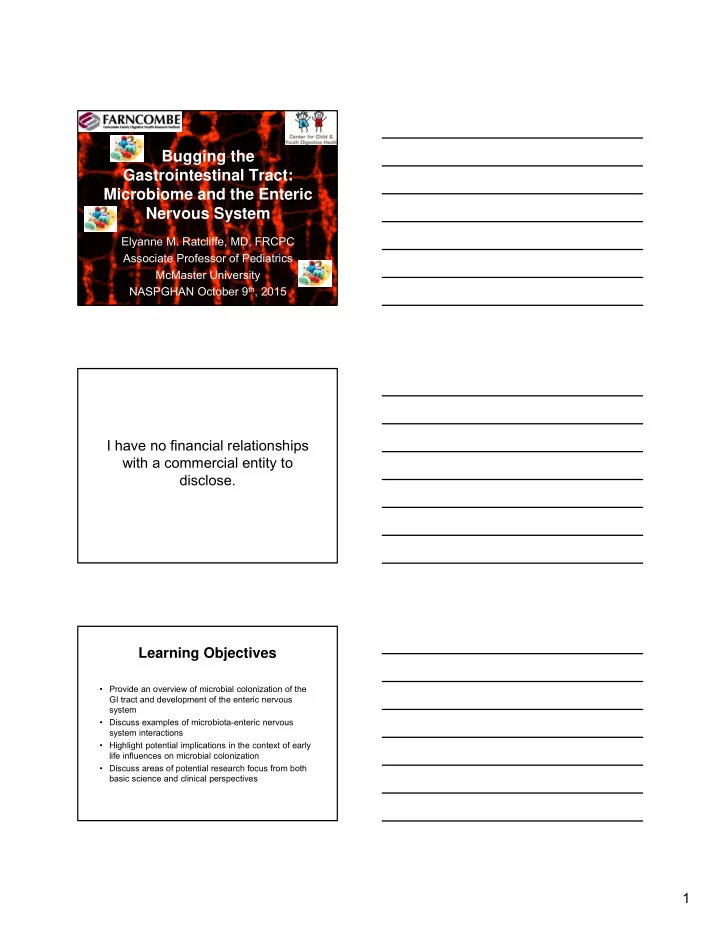

Bugging the Gastrointestinal Tract: Microbiome and the Enteric Nervous System Elyanne M. Ratcliffe, MD, FRCPC Associate Professor of Pediatrics McMaster University NASPGHAN October 9 th , 2015 I have no financial relationships with a commercial entity to disclose. Learning Objectives • Provide an overview of microbial colonization of the GI tract and development of the enteric nervous system • Discuss examples of microbiota-enteric nervous system interactions • Highlight potential implications in the context of early life influences on microbial colonization • Discuss areas of potential research focus from both basic science and clinical perspectives 1
Pediatric disorders of GI motility are common… …but not well understood Medications Nutrition A microbiome is born Palmer PLoS Biol 2007 Penders Pediatrics 2006 2
The ENS continues to develop in early postnatal life ENCDCs Myenteric and ENS colonize gut submucosal Plasticity by E9 plexi form by E12/13 Birth E19/20 Introduction Microbiome of intestinal plasticity bacteria Schafer Anat Record1999 de Vries Am J Physiol 2010 Foong J Physiol 2012 Hooper Trends in Microbiol 2004 Bacteria can influence the ENS Probiotic-induced changes Probiotic-induced changes in chemical coding of in gut physiology enteric neurons • Lactobacillus reuteri (JB-1) • Saccharomyces boulardii – ↓ amplitude of jejunal and – ↓ calbindin colonic contractions immunoreactive neurons – Mimicked by IK Ca channel blocker • Pediococcus acidilactici – ↑ galanin and CGRP • Bifidobacterium longum immunoreactive neurons – ↓ AH neuron excitability Kamm Neurogastroenterol Motility 2004 Di Giancamillo Neurogastroenterol Motil 2010 Wang Neurogastroenterol Motil 2010 Wang FASEB 2010 Khoshdel Neurogastroenterol Motil 2013 HYPOTHESIS: HYPOTHESIS: Intestinal microbiota can influence the Intestinal microbiota can influence the postnatal development of the ENS postnatal development of the ENS 3
Axenic/Gnotobiotic Mouse Facility • Specific pathogen-free (SPF) mice • Germ-free (GF) mice • Altered Schaedler Flora (ASF) mice – Standardized microbiota – 8 strains: 6 gram-positive and 2 gram-negative Furness, 2006 Furness The myenteric plexus is hypoplastic in GF mice at P3 Collins Neurogastroenterol Motil 2013 4
Simplified flora sufficient for normal ENS formation Collins Neurogastroenterol Motil 2014 Neuronal cell bodies per myenteric ganglion are decreased in GF mice at P3 Collins Neurogastroenterol Motil 2014 Which populations of neurons contribute to the abnormal ENS in GF mice? Chalazonitis Develop Neurobiol 2012 5
Serotonergic neurons P1 Ileum P1 Colon SPF GF Number of 5-TH-positive myenteric neurons per square millimeter of tissue P1 P7 P28 P7 Ileum P7 Colon P28 Ileum P28 Colon Human neuronal protein C/D (Hu) 5-hydroxytryptamine (5-HT) Mungovan JPGN Abstract 2013 Nitrergic neurons are increased in GF mice at P3 Collins Neurogastroenterol Motil 2014 Collins, 2013 Dopaminergic neurons are decreased in GF mice at P7 and P28 P1 Ileum P1 Colon SPF #TH cells/mm 2 GF Number of TH-positive myenteric neurons per square millimeter of tissue. (p < 0.05) P1 P7 P28 P7 Ileum P7 Colon #TH cells/mm 2 P28 Ileum P28 Colon #TH cells/mm 2 Human neuronal protein C/D (Hu) Tyrosine hydroxylase (TH) Mungovan JPGN Abstract 2013 6
Spatiotemporal mapping SPF GF Intestinal contractions are decreased in GF mice at P3 Collins Neurogastroenterol Motil 2014 Intestinal contractions are increased by nitrergic inhibition (NOLA) Collins Neurogastroenterol Motil 2014 7
Potential mechanisms Mungovan and Ratcliffe The Gut-Brain Axis in press 2015 Bacterial components • Majority of emerging research has been identifying toll-like receptors (TLR) in mediating microbial-ENS interactions LPS PGN • TLR4: Present in the ENS (postnatal and adult); Mice lacking TLR4 have an abnormal ENS; Exposure to LPS can stimulate enteric neurons (Rumio J Cell Physiol 2006; Anitha Gastro 2012) • TLR2: Present in the ENS, enteric glia and intestinal smooth muscle; Mice lacking TLR2 have an abnormal ENS; ENS defects seem to be mediated by GDNF (Brun Gastro 2013) Kamada and Kao Gastro 2013 Epithelial cells • Intestinal microbiota are necessary for the normal excitability of IPANs (MacVey Neufeld Neurogastroenterol Motil 2009) • Microvesicles were formed from Lactobacillus rhamnosus (JB-1) and enriched for heat-shock protein components (Al-Nedawai FASEB J 2015) – Only produced functional effects on enteric neurons when applied to the epithelium – No effects when applied to enteric neurons directly 8
Enterochromaffin cells and immunocytes • Interactions between bacteria and the ENS could also be mediated through: Bisbenzimide – Enterochromaffin cells (Rhee 5-HT Nature Rev 2009); No significant difference in EC cells between GF and SPF mice (P1-P28; Mungovan SPF JPGN abstract 2013) GF – Immune cells e.g. macrophages in the muscularis externa (Muller Cell 2014) Clinical implications • Microbiota might play a role in the pathophysiology of GI motility disorders: – Children exposed to antibiotics in early life have been found to have an increased incidence of abdominal pain (Uusijarvi Gastro 2012) – Altered stool microbiota profiles have been found in children with irritable bowel syndrome and with constipation (Rigsbee Am J Gastro 2012; Zoppi Acta Paediatr 1998) • Probiotics have therapeutic potential: – Premature infants treated with Lactobacillus reuteri have a significant decrease in regurgitation and increase in the rate of gastric emptying (Indrio J Pediatr 2008) – Infants treated with Lactobacillus reuteri for constipation have a significant increase in frequency of bowel movements (Coccorullo J Pediatr 2010) Conclusions • Intestinal microbiota can influence the normal development of the enteric innervation • Future studies are needed to investigate the potential mechanisms of microbial-ENS interactions • Clinical studies linking clinical presentations of GI motility disorders with pathophysiological findings should consider including microbiota profiling 9
• Verdu Lab AGU Staff • Huizinga Lab Sean Parsons • Khan Lab • Ratcliffe Lab Janice Kim Sharif Shajib Rajka Borojevic Josh Collins Kal Mungovan Jenna Dowhaniuk Kate Prowse Justin Brunet Megan Wang 10
Recommend
More recommend